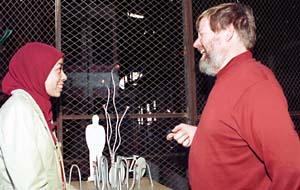With its dusty floors, cavernous ceilings and crumbling façade, the Laclede Power Building, 1246 Lewis St., is not your typical exhibition space.
On March 22, however, the shambling old structure, located at the head of the St. Louis Riverfront Trail just north of Laclede’s Landing, hosted dozens of proposals for unique, colorful and frequently whimsical bicycle racks designed by the 50 students in Architecture 212, the School of Architecture’s sophomore studio.

The class, led by affiliate associate professors Bill Wischmeyer, Jana Pereau and Gay Lorberbaum, recently teamed with Trailnet, a local not-for-profit organization that promotes bicycle transportation, to launch the Bicycle Art Rack Program.
Each student tailored a proposal, in the form of a quarter-scale model, to one of nine sites around St. Louis — three on the Landing, three in Soulard and three in South Grand.
In the coming months, those proposals will be shown to the general public as well as to representatives of the Soulard Beautification Committee, the Laclede’s Landing Redevelopment Corp. and other community groups. Organizers hope to select nine of the projects — or one per site — for actual construction.
“This is a great experience for architectural students to go through,” said Peter Clarkson, director of project development for Trailnet and an adjunct professor at the School of Architecture. “Knowing they have a chance to get something built really spurs them on. It brings out the artist in them.”
At the same time, the experience of working with actual clients provides a visceral appreciation for such real-world concerns as budget, materiel, location, safety and liability and public expectation.
“For most of the things architects do, these issues are almost as real as gravity,” Pereau said. “They don’t go away when you start designing buildings.”
Pereau added that the class frequently takes on “projects that have a community benefit,” and that previous Architecture 212 studios have resulted in a primate house and a cage for birds of prey at the Saint Louis Zoo, as well as a playground for disabled children in Forest Park.
“The students always come up with some amazing designs, things that you would never have thought of,” she said. “But the real service, more than any one project they’ve built, is simply helping to expand people’s vision of what’s possible.”
Still, the proposed budget of $1,000 per bike rack did tend to favor what Clarkson calls “street furniture”— relatively portable structures that can be built off-site and simply bolted into place — as opposed to, say, designs that require expensive poured foundations. And any bicycle rack has to meet certain basic parameters of height, thickness and number of points-of-contact for tires and locks.
Yet within those functional constraints comes an impressive range of poetic invention. Tara Neuhoff’s organic, vine-like design for the intersection of North Second and Lucas streets metaphorically represents the transformation of Laclede’s Landing from 19th-century industrial zone to 21st-century entertainment district. James Lewis’ quintet of 6-foot-tall anthropomorphic structures, situated near Vincent’s Market, 2400 S. 12th St. in Soulard, simultaneously recall figures in motion and the surrounding, tree-lined streets.
Yasmin Bhombal’s elegant, flower-like proposal for the Carpenter Branch of the St. Louis Public Library, 3309 S. Grand Ave., features copper detailing inspired by the building’s exterior and solar-powered lamps to illuminate the area at night.
Anne Nelsen captures the Landing’s “blend of the historic and the contemporary” with a playfully twisting, curving variation on the classic “slotted” bike rack. Located just a stone’s throw from the Mississippi, at the intersection of Laclede’s Landing and N. Leonor K. Sullivan boulevards, Nelson’s flood-resistant, all-metal design seems equally inspired by the Gateway Arch, the historic Eads Bridge and the glittering President Casino, all within sight.
What’s more, the piece’s ladder-like construction — two sidebars joined by short crossing ties — echoes the tracks on the old railroad trestle passing overhead.
“These projects are very site-specific, very much about the neighborhoods, and they give students an opportunity to discuss their work with people outside of academia, which is very different from talking to us as professors,” Wischmeyer said, adding that feedback has been extremely positive thus far.
“I think people have been delighted with the energy that went into these designs,” he said. Even those passionate bikers who at first “just wanted to know how they hook a bike up to it have seen the benefits of going beyond mere functionalism.”
The Bicycle Art Rack Program is funded by a grant from the William A. Kerr Foundation.
For more information, contact Clarkson at 436-1324, ex. 118, or at peterclarkson@trailnet.org.